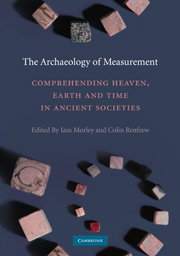Book contents
- Frontmatter
- Contents
- List of figures and tables
- List of contributors
- Acknowledgements
- The Archaeology of Measurement
- Introduction: Measure: Towards the construction of our world
- SECTION I NUMBER: COUNTING, MATHEMATICS AND MEASURE
- SECTION II MATERIALISING THE ECONOMY
- SECTION III DIMENSIONS AND BELIEF
- 10 Architectural measurements in the Indus cities: The case study of Mohenjo-Daro
- 11 Teotihuacan city layout as a cosmogram: Preliminary results of the 2007 Measurement Unit Study
- 12 Aztec dimensions of holiness
- 13 Establishing direction in early Egyptian burials and monumental architecture: Measurement and the spatial link with the ‘other’
- SECTION IV CALENDAR AND COSMOLOGY
- SECTION V THE SPIRITUALITY OF MEASURE
- Index
- References
12 - Aztec dimensions of holiness
Published online by Cambridge University Press: 05 June 2012
- Frontmatter
- Contents
- List of figures and tables
- List of contributors
- Acknowledgements
- The Archaeology of Measurement
- Introduction: Measure: Towards the construction of our world
- SECTION I NUMBER: COUNTING, MATHEMATICS AND MEASURE
- SECTION II MATERIALISING THE ECONOMY
- SECTION III DIMENSIONS AND BELIEF
- 10 Architectural measurements in the Indus cities: The case study of Mohenjo-Daro
- 11 Teotihuacan city layout as a cosmogram: Preliminary results of the 2007 Measurement Unit Study
- 12 Aztec dimensions of holiness
- 13 Establishing direction in early Egyptian burials and monumental architecture: Measurement and the spatial link with the ‘other’
- SECTION IV CALENDAR AND COSMOLOGY
- SECTION V THE SPIRITUALITY OF MEASURE
- Index
- References
Summary
In this chapter I investigate the possibility that the Aztecs constructed their ritual precinct at Tenochtitlan along the dimensions of sacred time. Saburo Sugiyama makes this point for Teotihuacan (1993; 2005; this volume), and I have made similar claims for even earlier centers (Clark 2001; 2004a, b). These proposals for Mesoamerican centers have relied on analyses of archaeological data to infer ancient units of measure and their numerical modularities. I reverse the procedure here and start with verified Aztec units of measurement and deploy them to propose numerical values for the dimensions of palaces, temples, and plazas. Discussion is organized in three parts. I first summarize the Aztec system of linear measurements. Next follows my evaluation of the dimensions of two palaces known from early historic records. Finally, I analyze the most current information for the ceremonial precinct of Tenochtitlan (now downtown Mexico City) in light of different native units of measure. These two applications of native measures to public architecture support the premise that the Aztecs, as did earlier Mesoamericans, built their sacred center to accord with the dimensions of sacred time.
Aztec linear units and their metric values
Aztec linear measures were calibrated to the human body, and in ways similar to the Spanish system to which it was later correlated. Both the Spanish and the Aztecs emphasized various arm measures, particularly the braza. A braza was two varas long.
- Type
- Chapter
- Information
- The Archaeology of MeasurementComprehending Heaven, Earth and Time in Ancient Societies, pp. 150 - 169Publisher: Cambridge University PressPrint publication year: 2010
References
- 5
- Cited by



